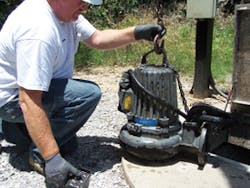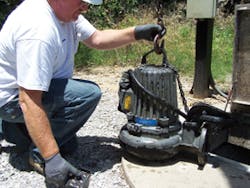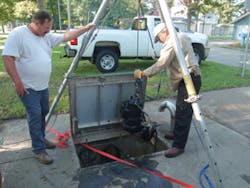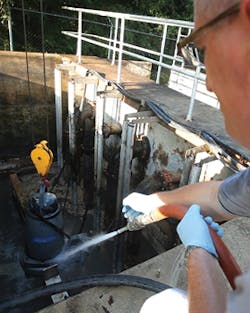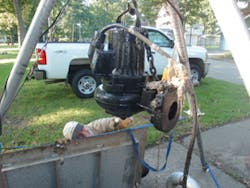Drinking water and wastewater systems account for up to 4% of the energy use in the United States, according to the Consortium for Energy Efficiency. Some 52,000 water systems produce 51 billion gallons of water per day, while 16,320 wastewater treatment facilities treat 34.8 billion gallons per day.
“What comes from that is the greatest energy consumer in water treatment is pumps,” notes Bob Domkowski, an engineering consultant and business development manager for Flygt Products, a division of Xylem.
In wastewater treatment, pumps are second to blowers in being the greatest consumers of energy.
“Pumps are not only a very important part of the process, but also a way to conserve energy and control operational costs,” points out Domkowski.
Indeed, water and wastewater utilities strive to focus on pump management and maintenance in such a way that addresses energy demand and power usage either through traditional approaches or improvements and innovations. At 40%, energy comprises the largest typical life-cycle cost for a pumping system, followed by maintenance at 25%, according to EPA.
For Domkowski, the effects of energy efficiency are not insignificant. “If you can affect energy savings, you can affect the 40% piece of that pie,” he says.
Engineers and end users have been increasing efficiency and lowering operation costs through a number of approaches, with the primary one being maintenance.
According to Domkowski, it’s not only the pump itself, but the pumping system itself that is essential. As he explains, in a fine-tuned system, the pump must, “ensure that, from the inflow approach to the pumps, it is designed properly, there is no swirling, and there is a direct flow to the machines.”
On the discharge side, maintenance ensures all equipment, including the valve, is operating properly so that the motor drive and pump are not operating at too high of a head, causing more energy to be consumed, or having a valve that gets stuck open and recirculates water back into the sump. When that happens, says Domkowski, “you’re really not doing any appreciable work but consuming energy.”
Premium efficiency motors and adjustable speed drives (ASD) or variable speed drives (VSD) are significant players in the system, he adds.
Domkowski believes proper application of VSD is critical. “Some people think just applying a VSD is going to be nirvana, and you’ll get the result of a great savings,” he says, “but it really depends on a pump system having a in a system that has a flat system head curve. A very small change in speed causes a dramatic change in pumping volume. You may not see much benefit at all if you have a flat system head curve.
“Wrongly, somebody may apply an adjustable speed drive and spend a significant amount of money with very little or zero return.”
There’s a dividing line between continuing maintenance and retrofitting or replacing system components. It’s called BER–beyond economical repair, and it’s determined at the time a machine is being serviced.
“A quote is provided back to the end user,” says Domkowski. “In most cases, they’re very astute to know approximately what the value of the piece of equipment is and whether it should be repaired.”
Generally, if it’s over 50% to repair a machine, which has about 10 years on it, “you’re going to give strong
Pump rehab in action
consideration to buying a new piece of machinery,” he adds.
On the wastewater side, the system’s ability to handle “modern trash” is the litmus test. This type of trash includes products that were not on the market years ago, such as baby wipes and cleaning pads for mops. The basis of all of these products is a non-woven sheet, akin to a dryer sheet.
“Once the material has been consumed in the dryer, you’re left with this thin, non-woven polyester sheet that is really tough,” says Domkowski. “It’s hard to cut them; you can’t tear them. That is the material that is the carrier sheet for all of these new products that are coming to market at a rate of three to five new products per month.”
Those products are entering the collection systems and becoming a “huge” challenge for collection system operators, he says.
“This material gets impinged or stuck in the impellers and partially clogs them up,” he adds. “The partially clogged pumps now have lower efficiency, and the pumps operate for longer periods of time for the same amount of work, unnecessarily consuming energy.”
Modern systems designed with the ability to self-clean are struggling, says Domkowski. “Most of the impellers used in wastewater are derivatives from a design in 1915, which is a blunt leading edge. That cannot handle today’s modern trash and it’s really not energy efficient.”
A utility can save several hundred dollars a month in energy charges by making sure to implement sustained cleanliness of the impeller.
“The cost of a maintenance crew to pull a machine out and unclog it costs the utility from $300 to $1,000 per occurrence,” says Domkowski. “Their maintenance budget is under stress to the extent that utilities have reported that it costs them $18,000 to $20,000 per year to maintain that lift station because they have to send crews out on a regular basis to unclog their pumps. The energy savings or benefit is dwarfed by their maintenance savings.”
Designing for future growth is critical for pump management, Domkowski says.
“On the wastewater side, a pump station will be designed for the current needs, but also for future growth.
There are a number of ways to accomplish that, which would be to put small pumps in initially, and then, in the future, take those pumps out and replace them.”
Another method initially uses a smaller impeller, and a larger one is put in the same pump later on.
“That can be less efficient because they may not be using the best choice initially,” says Domkowski. “In many cases, that future growth build-out never comes. The end-user is using much more energy than necessary because the plans called for two more housing developments to go in and we all know how housing starts have been in the last four years.
It’s a tricky balance, and a system’s capability cannot necessarily be judged by current circumstances. As Domkowski points out, “You’re either running with smaller machines that may not be as efficient or may not be the best choice, where ultimately if everything was built out, it turns out to be a great choice.”
In Andalusia, AL, stimulus money from the American Recovery and Reinvestment Act offered a $250,000 US Department of Energy block grant through Alabama’s Department of Economic and Community affairs for pump replacement with N-Pumps resulted in significant energy savings.
“You could use these energy efficiency grants to make improvements to public works if you could reduce the amount of your power consumption by at least 20%,” explains Bob Carter, P.E., and general manager of the Andalusia office of Goodwyn, Mills, and Cawood.
While stimulus money has been used for swapping out heating and cooling systems, streetlights, and traffic lights, Carter was cognizant that the city had pumps that needed to be upgraded in its sewage collection system. He also knew that Flygt’s new pump design guaranteed a minimum of 25% reduction of power consumption through its use.
With the grant, the city was able to replace aging pumps at two different pumps stations.
“As a part of the grant, we had to verify we saved the energy we said we were going to save,” says Carter. “We metered the consumption of electricity using the old pumps before we replaced the pumps. We metered it again after the new pumps were installed.”
Energy reductions were measured at 48.1% at one station and 56.1% at the other station.
efficiency is an ongoing goal.
A water or wastewater utility looking to upgrade its pump system should first assess its needs, Carter says.
“They would need to have some kind of goal they were trying to achieve,” he says. “If all they wanted to do was save power, they would need to determine where their biggest power users were in terms of their pumps, and maybe replace those pumps.”
Flygt’s new, patented impeller, the N-impeller, offers the energy savings, Carter notes.
“The actual pump efficiency is not that much different than with other pumps, or even with other Flygt pumps, but the energy savings come in the way the pumps pass solids,” says Carter. “They don’t tend to clog up or bind up, which pulls more power with the pump trying to cut through the solids. That’s how these pumps save the power.”
“It may or may not be, even though it may use less power,” he says. “They have to evaluate that. In their evaluation, they should include the fact that the operating cost, in terms of energy consumption, would be less than other pumps.”
Two years ago, American Water embarked on a multi-year program in an effort toward reducing the company’s energy demands.
“There are different ways to go about that, but improving pump efficiency is the biggest piece of the pie,” says Doug Potts, P.E., senior design engineer for American Water. “We’ve estimated that more than 95% of the electrical energy we expend at American Water is for pumping water. The rest of that is for offices and treatment processes.”
The multi-year program tests the efficiency of the company’s largest pumps at the top 50 plants in its operations throughout 20 states. With the efficiency tests nearly complete, the next step will be for American Water’s individual state subsidiaries to assess whether to rehabilitate or replace the low-efficiency pumps.
“If the efficiencies have declined just a little bit, there’s nothing to do with it, but if they decline more than 10% in efficiency below the current efficiency, then that would be a pump worth looking at,” says Potts. “We’d take a pump out of service, inspect it for what might be causing that decline in efficiency, and do appropriate rehabilitation work, or, in some cases, replace the pump entirely to incur that efficiency.”
By rehabilitating a pump, you can get the pump close to the efficiency it had when it was new, Potts points out. The engineering and production groups in American Water’s state subsidiaries have been working on where they should expend their efforts and which pump stations they should work on to improve the efficiencies.
“It doesn’t take much to improve the efficiency of a pump,” says Potts. “A pump is basically a mechanical piece of equipment and not very complicated. There are just a few basic things you can do to improve its efficiency.”
As the pump and motor work in concert, the electric motors alone are not usually the main culprit for reduced efficiency, Potts says.
“Electric motors decline in efficiency, but they don’t decline that much,” he says. “It’s a matter of the windings and the type of insulation in the motor, and that breaks down over time. That’s creating more heat, and that’s a loss of energy.”
Today’s motors are about 94% efficient, Potts says, adding that older motors were about 90% efficient when they were new.
“If we’re going to do a pump project, it makes sense to replace the motor, because a lot of motors are 50 years old or older,” he says. “If you’re going to spend the money to replace the pump, it makes sense to replace the motor. The biggest opportunity for improving efficiency in motors is the mechanical pump.”
Factors that affect efficiency include wear rings around the impeller and the casing.
“When they’re new, they’re designed to have a certain clearance,” says Potts. “If that clearance becomes too large, then there is water recirculating from the high-pressure side to the low-pressure side of the pump.”
And while water is needed to provide the cooling and lubrication for the wearing surface, over time, the clearance opens up with the water recirculating on the high-pressure side and the low-pressure side, resulting in an efficiency loss. When pumps are taken out and serviced for rehabilitation, it’s best to measure the clearances to see if they are out of tolerance. If so, the wear rings are replaced to reinstate normal clearances to help provide optimal efficiency for the pumps.
Wetted surfaces, where water passes at a high velocity, are another challenge.
“Over time, that surface becomes pitted for different reasons,” points out Potts. “Some of it is normal wear and tear. In some cases–especially if it’s a raw water pump–there might be some sand and grit that gets in there and wears it down.
“In some cases, you might have a cavitation,” he continues. “That’s where you want to look at those pitting areas, filling them in with some type of metalizing compound.”
Regardless of the surface condition, American Water recommends coating the wetted surfaces of the pump with a ceramic epoxy once the pitting has been corrected.
“There are some good products on the market that we’ve been trying out, but have gotten good comments from people who have used these coatings,” says Potts. “They’re strong enough to help prevent additional pitting, but they’re also incredibly smooth. A smoother surface on the inside of the pump helps to improve the efficiency, as well.”
Bearings can also affect efficiency and should be replaced as needed, says Potts, who believes pump systems designed for the future will incorporate more water efficient features. American Water has been in discussions with its engineers regarding more innovative design approaches. For a new treatment plant or pump station, a traditional design approach looks at the maximum demand that’s projected on the planning horizon, which is a 10- or 15-year horizon.
“The design point for that pump is the maximum flow–or the maximum daily demand–and the maximum pressure. You need to do that because your facility needs to be able to meet those demands, but the problem is in a normal day, the pump’s not normally operating at that specific operating point. It’s probably operating at a lower flow or a lower head,” says Potts.
“That means the pump is operating away from its best efficiency point. It still does everything you need it to do,” he adds. “A designer is going to want to pick a pump where its design point is close to its best efficiency point, but in the real world that pump normally operates at a point other than the best efficiency point.”
Ten percent in either direction is acceptable in normal operations, says Potts.
“If your normal operations are getting outside of that range, then you have a pump that might be brand new, and it might be a very efficient pump, but its normal operating point is running at a lower efficiency.
“We’re trying to encourage people to pick the pump for the max head and max flow, but also look at historical operating data,” says Potts. “In the majority of the time, what is the head flow range that facility would normally operate in? Pick the pump so that your best efficiency point is close to that.”
That creates two criteria for choosing a pump, Potts says.
“One is that there are times during the year where you still have to meet the max head and flow, but maybe that max head and flow point is not your most efficient point,” he says. “You want your most efficient point to be the point at which the pump lives most of the time, because that’s where most of the energy is consumed. That’s a shift from the traditional design approach.”
Potts points out that for those utilities not concerned about energy costs, the fall back condition is to run a pump until it fails.
“You can get away with that, because as long as a pump is pumping the amount of water needed, people are usually happy, but the downside of operating that way is twofold: one is that you risk having an unplanned failure of that pump because you weren’t maintaining it, and two, the pump may have operating at a low efficiency, and you weren’t aware of it because you weren’t testing it.”
That speaks to the benefit of routine maintenance checks on the bearings, clearances, and surfaces that are contact with water inside the pump to ensure they are smooth.
“Otherwise you might be running a pump that appears to be working fine but is running at a low efficiency, and there’s a real cost to that,” says Potts. “If we spend the effort to have a regular maintenance program on the pumps, that maintenance program can really pay for itself in terms of the cost of having an unplanned pump failure.
“Now you’ve got to get your pump fixed in a big hurry by a local shop, and you’re going to pay a premium for that, as opposed to planning ahead and doing it in a more orderly fashion.”
BLACOH Fluid Control manufactures fluid control products to improve pump performance. Among those products is a pulsation dampener to change the flow from pulsing to smooth so utilities can get better injection and more accurate measurement of chemicals, says Gary Cornell, CEO for BLACOH Fluid Control, who goes on to explain that–in a sense–this helps with energy consumption.
“When you have a dampener that keeps the flow constant and steady instead of starting and stopping, it uses less energy in the pumping cycle, so in that small way, we do contribute to some energy conservation,” says Cornell.
It cuts down on maintenance issues as well, he adds.
“Since the injection system no longer has this starting/stopping pulsing flow, the flow is even and therefore the pressure is even,” says Cornell. “There is less strain on the pipes, the valves, the gauges, and the fittings, so that we minimize maintenance on those injection systems.”
Such efforts tie into an overall need to address the water/energy nexus.
Dr. Allan Hoffman, a senior analyst with the Office of Energy Efficiency and Renewable Energy for the US Department of Energy (DOE), writes in a paper on water and energy that affordable energy and water is in short supply.
“Water, in absolute terms, is not in short supply in the world,” he says. “The earth is a water-rich planet, and annual human and animal consumption is much less than 1% of the world’s total water supply. What is in short supply is cheap potable water, clean water that people can afford to buy.”
Energy is required to lift water from depth in aquifers, pump water through canals and pipes, control water flow, treat wastewater, and desalinate brackish and seawater, Hoffman points out. Water is required for energy production such as hydropower, cooling of thermal power plants, fossil fuel production and processing, biofuels, carbon capture and sequestration, and hydrogen production.
Commercial energy consumed for delivering water is 26 Quads or 7% of the total world energy consumption.
Some examples:
- Lifting water from a depth of 100 feet at a flow rate of 20 gallons per minute, assuming an overall pump efficiency of 50%, requires 1 horsepower.
- Pumping water through pipes: moving water uphill 100 feet at 3 feet per second through a pipeline that is 1 mile long and 2 inches in diameter requires 4.8 horsepower.
- Energy needed to treat water: the average energy use for water treatment drawn from southern California studies is 652 kWh per acre-foot (AF), where 1 AF = 325,853 gallons.
“We can no longer take water resources for granted if the US is to achieve energy security in the years ahead,” writes Hoffman. “Water and energy are also the critical elements of sustainable development, a major goal of US foreign policy. Without access to both, economic growth and job creation cannot take place and poverty cannot be averted.”
Recognizing and acting upon the link between water and energy security requires an enhanced partnership between the federal government–which has primary responsibility for energy security–and the states, where water issues have historically been addressed, he adds.
In a 2010 article for the Journal of Energy Security titled “The Water-Energy Conundrum: Can We Satisfy the Need for Both?”, Hoffman writes of an increasing acceptance of the energy/water nexus. He points out that with energy needed to ensure delivery of water services, and water is needed to produce fuels and energy–and as demand for one increases, so does the demand for the other.
The International Energy Outlook 2010 of the US DOE’s Energy Information Administration projects the total world energy demand will rise from 510 quads today (a quad is one quadrillion BTUs) to 740 quads in 2035. With global demands for potable water increasing as well, Hoffman believes there’s a “conundrum” of whether the increased demands for water and energy can be met in a timely and environmentally safe manner when water and energy policy goals often conflict.
“This was not a problem in 1900 when the world’s population was 1.8 billion, but with today’s population of seven billion, estimated to reach eight to 10 billion in 2050, a serious, and perhaps overwhelming, problem exists: how do we ensure water and energy security?” asks Hoffman.
He concludes energy security must ultimately rest on two principles: using the least amount of energy to provide a given service, and access to technologies that provide a diverse supply of reliable, affordable, and environmentally benign energy.
The top priority of any national energy policy must be the “wise, efficient use” of available energy supplies, be they fossil, nuclear, or renewable, Hoffman asserts. The next priority is new supplies that meet cost, sustainability, and environmental requirements. These priorities apply equally to water, he adds. Hoffman writes “we will not run out of water or energy, but we will undoubtedly have to pay more, for both.”
As such, government officials are too often reluctant to articulate that message if it involves higher costs and adverse political reaction, he adds.
“People want more energy and clean water, but are reluctant to pay more for the,” he concludes, adding that it’s an economic and political issue, not a technical one.
To that end, less reliance on traditional fossil fuels and more on renewable energy resources such as solar, wind, geothermal, biomass, hydropower, and ocean energy can offer “stabilization of long-term energy costs, reduced market uncertainties, reduced international competition for energy resources, reduced greenhouse gas emissions, enhanced job creation, and the ability to keep an increasing share of payments for energy supplies at home where they can be used for domestic investment,” writes Hoffman.
In a 2010 presentation titled “Water & Energy in Changing Climates: State, Federal and Local Views” to the Groundwater Protection Council, Hoffman told attendees that many federal agencies address water issues, but generally not the water-energy nexus, although this may be changing:
- The Energy and Water Research Integration Act requires the DOE to integrate water-related issues into current R&D programs. Hoffman adds that a broad range of water-energy R&D activities is supported by the DOE, with the level of support likely to increase.
- The Energy and Water Integration Act of 2009 calls for in-depth analysis of the impact of energy development and production on water resources.
- The American Clean Energy and Security Act of 2009 calls attention to water requirements of the energy supply mix.
The Congressional Research Service also has prepared a report, “Energy’s Water Demand: Trends, Vulnerabilities, and Management,” (which can be found at www.fas.org/sgp/crs/misc/R41507.pdf). The 2010 report outlines potential federal policy options that meet water demands for energy production, the fastest-growing consumer of water.
KCI Technologies off ers services including feasibility studies, new facility construction, rate structure analysis for water supply, treatment, storage, and distribution, as well as wastewater conveyance and treatment.
Michael Sevener, senior project manager in the company’s water and wastewater division, has been doing presentations on energy embodied by the global hydrologic cycle and society’s overall energy use.
“KCI has been engaged in some projects in improving energy effi ciency, especially in pumping, which is generally recognized as the largest single energy consumer in water and wastewater,” says Sevener. “If you look at the systems in a whole, it’s moving water around.”
One approach to address the challenge is water demand reduction, similar to the demand reduction and control effort that has been going on in the electric industry for decades now, Sevener says. “That ties into the efficiency of how we use the water in our homes and industries,” he explains.
Sevener points out that EPA’s WaterSense program offers opportunities in the residential sector. “There is lots of work going on looking for ways to reduce water use on the industrial side and particularly in power generation, which is one of the largest water consumers in the nation,” he says. “They tie together and reinforce each other. Demand reduction is a simple way to reduce energy consumption with our water and wastewater all through the system.”
KCI has been involved in projects related to improving pump efficiencies. “Since the development of better variable frequency drives, there’s been a huge incentive for people who do a lot of water pumping to increase efficiency by tailoring output to inflows into a wastewater pump station,” he says. “You get some energy efficiencies that way, too.”
Addressing the challenge of efficient pumping systems, Sevener says the question centers on how to improve the systems, recognizing that pumping is one of the largest energy consumers in water systems.
Sevener references the Pump Systems Matter program offered by the Hydraulic Institute as one example of the work being done to improve the efficiency of pumping through the dissemination of information.
“There are a lot of people working on this, which is great,” he says. “On the engineering side, there’s more of an emphasis on improving technology through variable frequency drives and more efficient motors, more efficient pumps, and perhaps less recognition of the role the population at large can play in demand management. Something that we in the engineering community tend to forget about is the cultural context we work in.
“It’s not just machines and technology, and processes and calculation; it’s also a matter of public education and getting people to consume less water,” he adds. “I’m not going to say it improves efficiency, but it reduces your energy demand. When we talk about efficiency, what we’re really aiming at is how do we reduce our energy demand?”
That is of particular concern in states such as Texas, which has undergone a serious drought in the past few years. Leslie Savage, chief geologist for the Railroad Commission of Texas, Oil and Gas Division, points out that, historically, Texas has performed water planning and energy planning separately.
Her comments reflect the conclusions of a 2009 report by the University of Texas at Austin and the Environmental Defense Fund, “Energy-Water Nexus in Texas,” which promotes several recommendations:
- Applications for new power plants include an analysis of the water and efficiency implications of various cooling options.
- Require a clear demonstration of water availability in the siting of new fossil-fueled power plants or concentrated solar.
- Provide state statutory and regulatory incentives for implementation of power plant cooling technologies that are less water-intensive than traditional systems, such as aircooling or hybrid wet-dry cooling.
- Provide state-approved guidance from the Texas Water Development Board or the State Energy Conservation office to water suppliers and wastewater treatment providers to help quantify energy use and cost savings associated with water conservation.

